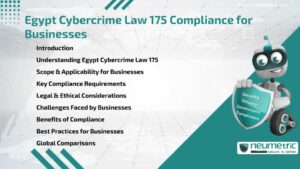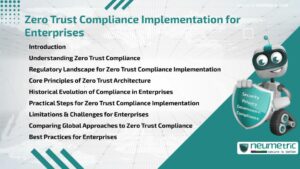Table of Contents
ToggleIntroduction
Zero Trust Compliance Implementation is becoming a critical priority for enterprises as Cyber Threats grow in scale & sophistication. Unlike traditional perimeter-based models, Zero Trust assumes that no user, device or system is inherently trustworthy. This approach requires continuous verification, least-privilege access & constant monitoring to meet Compliance standards. For enterprises, implementing Zero Trust not only ensures Regulatory Compliance but also strengthens Data Protection & reduces the Risk of breaches.
Understanding Zero Trust Compliance
Zero Trust is a Cybersecurity Framework that enforces strict Identity Verification & Continuous Monitoring of all users & devices. Compliance within this model involves aligning enterprise Security Controls with Legal & Regulatory obligations such as Data Protection Acts, Sectoral Regulations & international standards. Zero Trust Compliance Implementation therefore integrates both Security practices & Legal adherence.
Regulatory Landscape for Zero Trust Compliance Implementation
Enterprises today face multiple Compliance Requirements depending on jurisdiction & sector. The General Data Protection Regulation [GDPR] in the European Union, the Health Insurance Portability & Accountability Act [HIPAA] in the United States & the Reserve Bank of India guidelines are examples of frameworks that push firms toward Zero Trust principles. These frameworks demand robust identity management, Access Controls & Audit mechanisms to ensure Data Confidentiality & Integrity.
Core Principles of Zero Trust Architecture
The foundation of Zero Trust Compliance Implementation lies in three (3) Core Principles:
- Never Trust, Always Verify: Every request must be authenticated regardless of location.
- Least Privilege Access: Users are given only the access necessary to perform their tasks.
- Assume Breach: Systems are designed with the expectation of compromise, ensuring rapid containment.
By embedding these principles, enterprises can align with Compliance Requirements while reducing attack surfaces.
Historical Evolution of Compliance in Enterprises
Earlier, Compliance largely focused on perimeter defense, with firewalls & Access Controls as the main safeguards. However, the rise of cloud computing, remote work & sophisticated cyberattacks exposed weaknesses in this approach. Over the last decade, regulators & security leaders have increasingly adopted Zero Trust as a standard. This shift represents a transition from reactive to proactive Compliance strategies.
Practical Steps for Zero Trust Compliance Implementation
Enterprises can adopt the following measures to achieve Zero Trust Compliance:
- Deploy Multi-Factor Authentication across all systems
- Implement Micro-Segmentation of networks
- Monitor User behavior with Analytics & Threat detection tools
- Enforce continuous Access Validation Policies
- Maintain detailed Audit logs for Regulatory Reviews
These steps ensure both strong security & adherence to Compliance mandates.
Limitations & Challenges for Enterprises
Zero Trust Compliance Implementation, while effective, is not without challenges. Large enterprises may face integration difficulties when replacing legacy systems. High costs of advanced authentication tools can be a barrier for mid-sized firms. Additionally, achieving cultural change within Organisations, where Employees must adapt to stricter Access Controls, can be complex. Jurisdictional variations in Compliance standards also add layers of complexity.
Comparing Global Approaches to Zero Trust Compliance
The United States, through frameworks like the National Institute of Standards & Technology [NIST] Zero Trust Architecture, provides detailed guidance for enterprises. The European Union aligns its approach with GDPR, emphasizing consent & data minimisation. India’s evolving guidelines also encourage identity-based Access Control. Comparing these frameworks highlights a global convergence toward Zero Trust, though with variations in enforcement & penalties.
Best Practices for Enterprises
To successfully implement Zero Trust Compliance, enterprises should:
- Conduct regular Compliance Audits & Risk Assessments
- Train Employees on Zero Trust principles & Security awareness
- Use automation for policy enforcement & monitoring
- Collaborate with Third Party vendors that align with Compliance standards
- Continuously update systems against emerging Threats
Following these Best Practices helps enterprises balance Compliance Requirements with robust Security Measures.
Takeaways
- Zero Trust Compliance Implementation is essential for modern enterprises.
- Core Principles include continuous verification, least privilege & breach assumption.
- Regulatory frameworks like GDPR, HIPAA & RBI guidelines push firms toward Zero Trust.
- Challenges include legacy system integration, costs & organisational adaptation.
- Best Practices involve Audits, Employee Training, Automation & Vendor Compliance alignment.
FAQ
What is Zero Trust Compliance Implementation?
It is the process of aligning enterprise Security Measures with Zero Trust principles while meeting regulatory requirements.
Why is Zero Trust important for enterprises?
It reduces Risks by assuming no User or system is inherently trustworthy & enforces continuous verification.
Which regulations drive Zero Trust Compliance?
Regulations such as GDPR, HIPAA & RBI guidelines require strict identity management & monitoring aligned with Zero Trust principles.
How does Zero Trust differ from traditional security?
Traditional models rely on perimeter defenses, while Zero Trust requires continuous authentication & least-privilege access at all times.
What challenges do enterprises face in implementation?
Key challenges include high costs, integration with legacy systems & organisational resistance to stricter Security Controls.
Can Zero Trust Compliance benefit small enterprises?
Yes, though resource constraints may exist, small firms can adopt scaled approaches to improve security & meet Compliance needs.
How can enterprises measure success in Compliance?
By tracking reduced breach incidents, successful Audit results & improved Employee adoption of Zero Trust practices.
Need help for Security, Privacy, Governance & VAPT?
Neumetric provides organisations the necessary help to achieve their Cybersecurity, Compliance, Governance, Privacy, Certifications & Pentesting needs.
Organisations & Businesses, specifically those which provide SaaS & AI Solutions in the Fintech, BFSI & other regulated sectors, usually need a Cybersecurity Partner for meeting & maintaining the ongoing Security & Privacy needs & requirements of their Enterprise Clients & Privacy conscious Customers.
SOC 2, ISO 27001, ISO 42001, NIST, HIPAA, HECVAT, EU GDPR are some of the Frameworks that are served by Fusion – a SaaS, multimodular, multitenant, centralised, automated, Cybersecurity & Compliance Management system.
Neumetric also provides Expert Services for technical security which covers VAPT for Web Applications, APIs, iOS & Android Mobile Apps, Security Testing for AWS & other Cloud Environments & Cloud Infrastructure & other similar scopes.
Reach out to us by Email or filling out the Contact Form…





